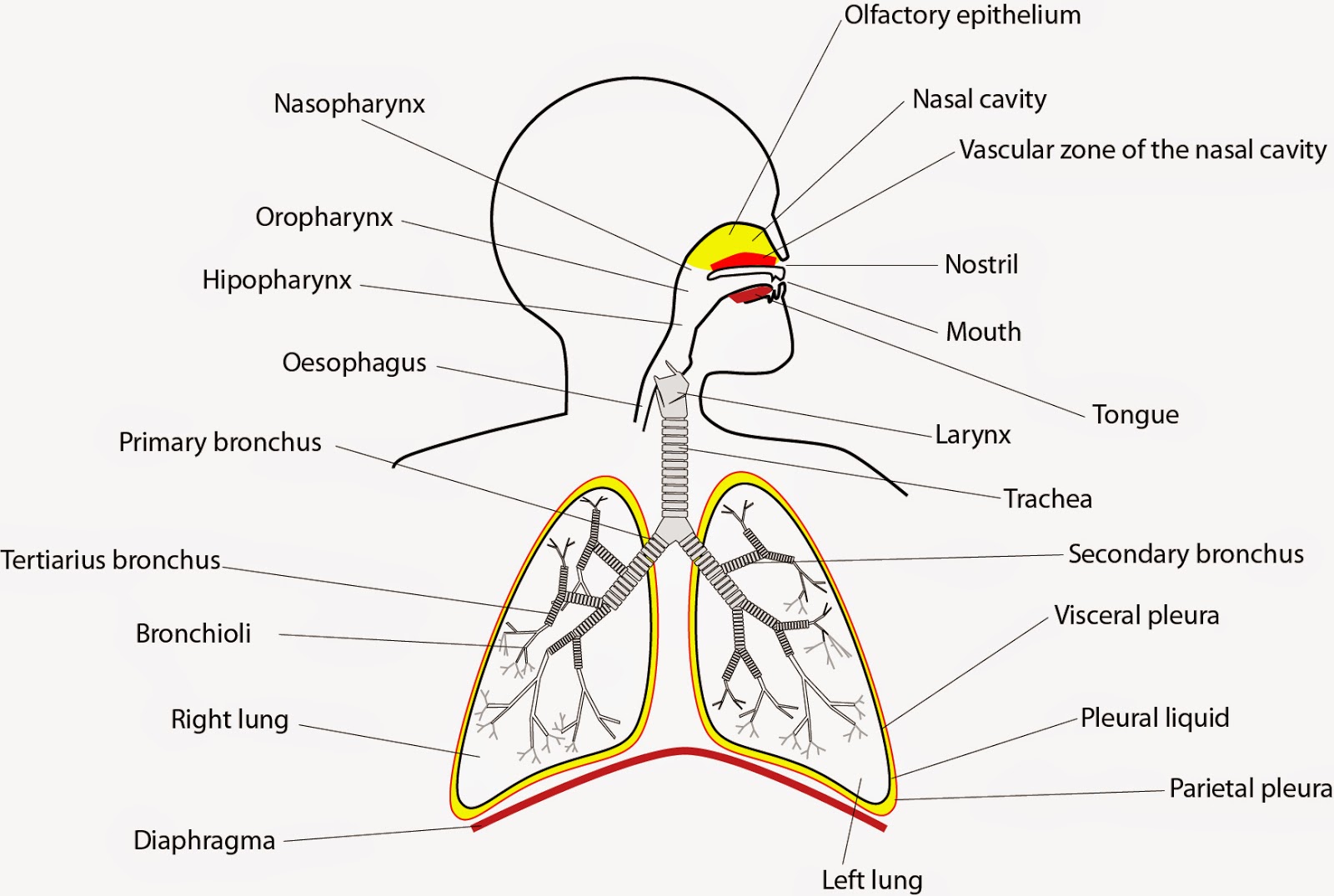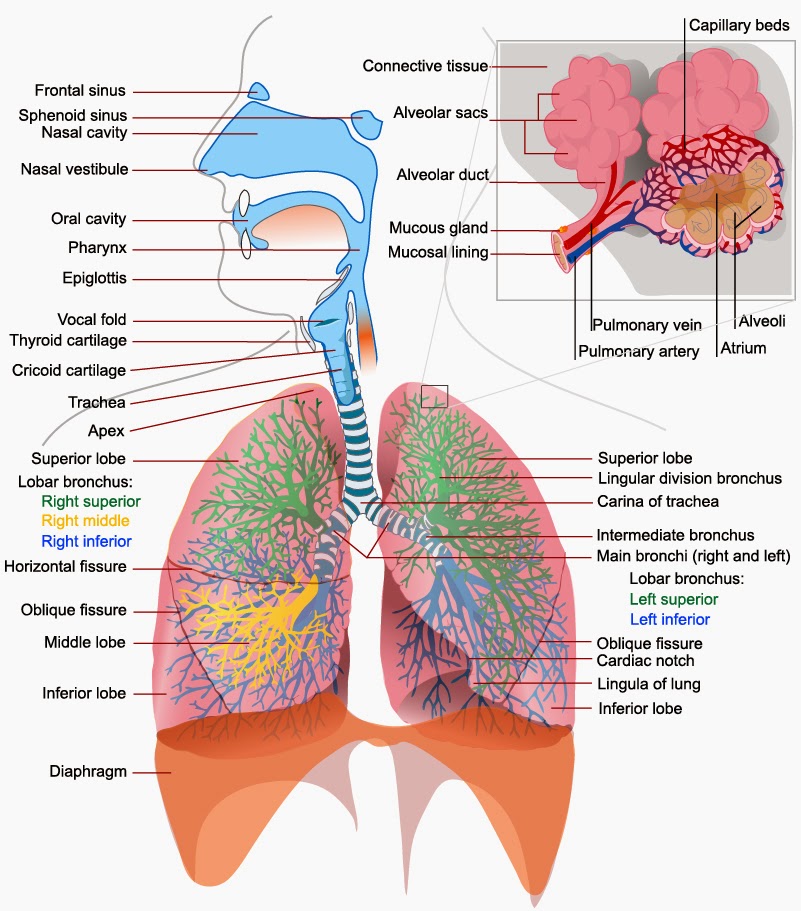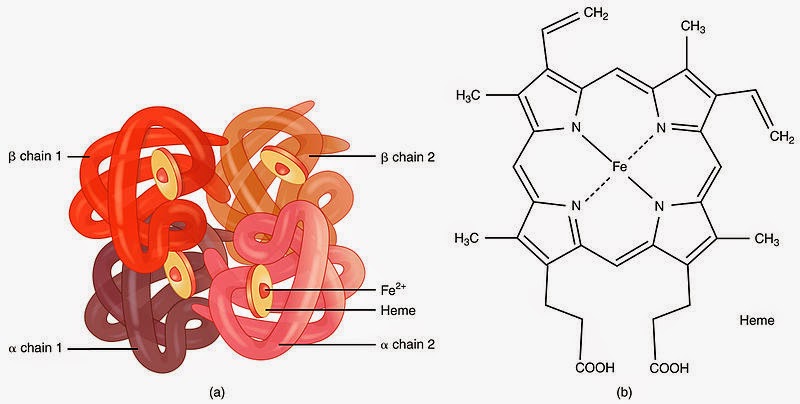Biology
- Lung Structure
Look at the following diagrams of the structure of the lung, can you use them to explain how oxygen enters the blood from the lungs and how carbon dioxide leaves the blood and enters the lungs? Watch this video clip below and then explain carefully...
- #50 The Gas Exchange System
All organisms take in gases from their environment and release gases to the environment. Animals take in O2 for aerobic respiration and release CO2. Plants also respire, but during daylight hours they photosynthesise at a greater rate than...
- #49.2 Gas Exchange And Smoking Syllabus 2016
9.1 The gas exchange system 9.2 Smoking The gas exchange system is responsible for the uptake of oxygen into the blood and excreting carbon dioxide. An understanding of this system shows how cells, tissues and organs function...
- #45 The Components Of Blood, O2 And Co2 Transport
The body contains approximately 5 litres of blood and this is a mixture made up of red blood cells, white blood cells and platelets all suspended in a liquid called plasma. 1. Blood components Red blood cellsTransport O2 from lungs...
- Breathing And Exchange Of Gases
Click here for PDFRespiration is the oxidation of nutrients in the living cells to release energy for biological work. Breathing is the exchange of O2 from the atmosphere with CO2 produced by the cells. Respiratory organs· General...
Biology
Respiration: Pulmonary Ventilation and Exchange of Gases
Respiration can be divided into three different consecutive processes: ventilation, external or pulmonary respiration and internal or tissular respiration.
 |
| Respiratory System |
Ventilation is the process related to the movement of the air, from the environment to the interior of our lungs and from the interior of our lungs to the environment. So, ventilation can also be split into two different processes, inhalation when the air flows into our lungs, and exhalation when the air flows from our lungs.
Our lungs have no inner muscles, the movement of the air depends on the muscular movements that involve the rib cage and the diaphragm. The lungs are surrounded by two thin tissular layers called pleurae. The outer one, called parietal pleura, covers the inner surface of the rig cage. The inner one, called visceral pleura, covers the surface of the lungs. Between these two pleura we can find a fluid called pleural liquid. Pleural liquid maintains both pleurae bounded.
When the rib cage moves, the parietal pleura moves too, and it leaves to the movement of visceral pleura, that is firmly stuck due to the pleural liquid. Visceral pleura moves lungs.
 |
| Respiratory System, by LadyofHats |
How does inhalation take place? It is quite simple. External intercostal muscles contract, and this movement makes the rib cage ascend. This makes the rib cage increase its volume. At the same time, the diaphragm contracts. Both muscular contractions cause the lungs to increase their volume, because they are bound to the rib cage and the diaphragm. So the pressure inside the lungs falls, and becomes lower than air pressure. Gases flow from places with high pressure to places with low pressure, so the air enters the lungs.
Exhalation is a passive process. Lung are made up of many contractile fibers, they are very elastic structures. So, when rib external intercostal muscles and diaphragm relax, the elastic properties of lungs make them return to their original size. Lungs decrease in size, so air pressure inside them rises and becomes higher than air pressure. And the air exits the lungs, because fluids flow from high pressure places to low pressure places.
Sometimes we need to increase the speed of inhalation and exhalation. when this happens the elastic properties of the lung are not sufficient to maintain the ventilatory rate. We must expel air more quickly. This process is called forced exhalation, and is carried out by internal intercostal muscles and abdominal muscles. When these muscles contract, the rib cage returns to its original position very quickly, making the lungs shrink in few seconds.
This happens, for instance, when we are doing physical exercise and we need to breathe quickly to provide oxygen to our muscles, or when we want to shout, or whistle or even sing.
 |
| Inhalation and exhalation |
When we talk about external respiration we refer to the process of gases exchange between lungs and blood. It takes place in pulmonar alveoli, tiny spherical structures of our lungs, covered by a very thin epithelial layer and surrounded by capilar vessels.
The air from our environment enters into the alveoli (thanks to inhalation). This air is rich in oxygen, but has a low quantity of carbon dioxide. The blood that has reached the capilar vessels of the alveoli comes from the body, and has a low quantity of oxygen, and a high quantity of carbon dioxide.
Chemical substances tend to move from high concentration places to low concentration places (this is called osmosis), so oxygen moves from the air to the blood, whereas carbon dioxide moves from the blood to the air. This process is called pulmonary or external respiration.
Due to this, when the blood exits the lungs it has a high concentration of oxygen and a low concentration of carbon dioxide.
To improve the transport, oxygen travels in the blood linked to a protein called hemoglobin. This protein can be found inside the red cells (erythrocytes). This is the reason why erythrocytes are very important to our body: they are the cells that transport oxygen from the lungs to the tissues.
 |
| Hemoglobin and hero group by Openstax College |
Carbon dioxide travels in our blood transformed in carbonic acid. This is why when we consume a big amount of oxygen, because we are doing hard physical exercise, for instance, the pH of our blood decreases: the accumulation of carbon dioxide increase the amount of carbonic acid in the blood and acids tend to reduce the pH of solutions.
 |
| Respiratory System and Exchange of Gases, by NLHBI |
When the blood arrives at the tissues the situation is just the opposite as in the lungs: the erythrocytes are charged with oxygen, however the cells of the tissues have consumed the oxygen to obtain energy (during the cell respiration), so there are a low quantity of oxygen in there. On the other hand, cell respiration has produce a high amounts of carbon dioxide, so the tissues have a high quantity of this product.
This is the reason why oxygen moves from the blood (that comes from the lungs with high amounts of oxygen) to the tissues, and at the same time carbon dioxide moves from the tissues to the blood. This exchange is called tissular or internal respiration.
Deoxygenated blood, full of carbon dioxide, must return to the lungs to exchange gases again, and the cycle has been completed.
- Lung Structure
Look at the following diagrams of the structure of the lung, can you use them to explain how oxygen enters the blood from the lungs and how carbon dioxide leaves the blood and enters the lungs? Watch this video clip below and then explain carefully...
- #50 The Gas Exchange System
All organisms take in gases from their environment and release gases to the environment. Animals take in O2 for aerobic respiration and release CO2. Plants also respire, but during daylight hours they photosynthesise at a greater rate than...
- #49.2 Gas Exchange And Smoking Syllabus 2016
9.1 The gas exchange system 9.2 Smoking The gas exchange system is responsible for the uptake of oxygen into the blood and excreting carbon dioxide. An understanding of this system shows how cells, tissues and organs function...
- #45 The Components Of Blood, O2 And Co2 Transport
The body contains approximately 5 litres of blood and this is a mixture made up of red blood cells, white blood cells and platelets all suspended in a liquid called plasma. 1. Blood components Red blood cellsTransport O2 from lungs...
- Breathing And Exchange Of Gases
Click here for PDFRespiration is the oxidation of nutrients in the living cells to release energy for biological work. Breathing is the exchange of O2 from the atmosphere with CO2 produced by the cells. Respiratory organs· General...
